Last-Minute NYC Holiday Gift Guide 🎁
We’ve created a holiday gift guide with presents for the intrepid New Yorker that should arrive just in time—


A Russian fortune teller, a German saloon owner, and an Irish family of ten are just a few former residents of 97 Orchard Street. Built in 1863, the Orchard Street tenement was home to generations of immigrants and their families in Manhattan’s Lower East Side. The building sat vacant for decades after it was abandoned in the 1930s. Fifty years later, it was discovered by Ruth Abram, founder of The Tenement Museum. A massive restoration project preserved and transformed the multi-family dwelling into an engaging space where New Yorkers could explore the stories of those who lived and worked there. The renovations unearthed a wealth of treasures that revealed what life for immigrants was like in the 19th and early 20th-centuries. We’ve worked with The Tenement Museum to compile a list of its top 10 secrets, from the most surprising floorboard finds to quirky stories of its former residents!
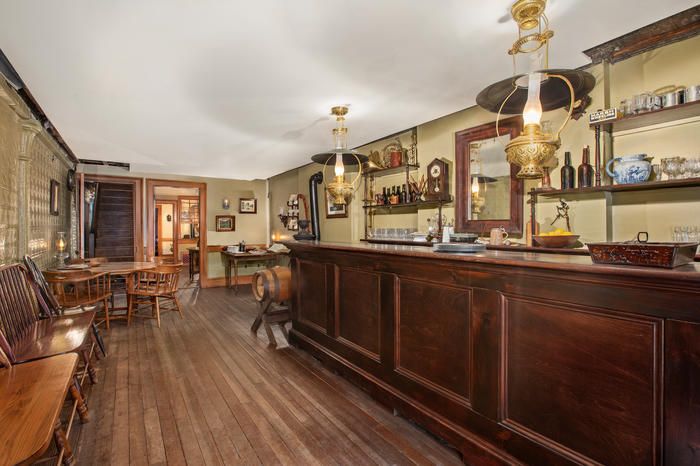
Photograph by Ryan Lahiff, Courtesy of the Tenement Museum
The Tenement Museum sits in an area of Manhattan once known as Kleindeutschland, or “Little-Germany.” This ethnic enclave sprouted from an influx of German migration in the mid-19th-century. The neighborhood’s German-speaking immigrant population was so large, 153,938 strong, that it would have constituted the 5th largest German-speaking city in the world. As with all immigrant populations who came to New York, the Germans brought their own cultural food and beverages, most notably, lager beer.
The Lower East Side was home to 500 lager beer saloons! One of those saloons was inside the tenement at 97 Orchard Street. The saloon was run by the tenement building’s original owner, John Schneider, and his wife, Caroline. The Scheiders ran the saloon from 1864 through 1886.
 Courtesy of the Tenement Museum
Courtesy of the Tenement Museum
Over the years, Museum staff have discovered an array of interesting artifacts in a variety of interesting places around the building. Tiny treasures have been found underneath floorboards, behind fireplaces, and in other forgotten nooks and crannies. Some of the most shocking uncovered items include a mummified rat, a creepy doll head, and a petrified bagel! Other more common objects found throughout the apartments include hairpins, bits of newspaper, buttons, photographs, and an overdue library notice.
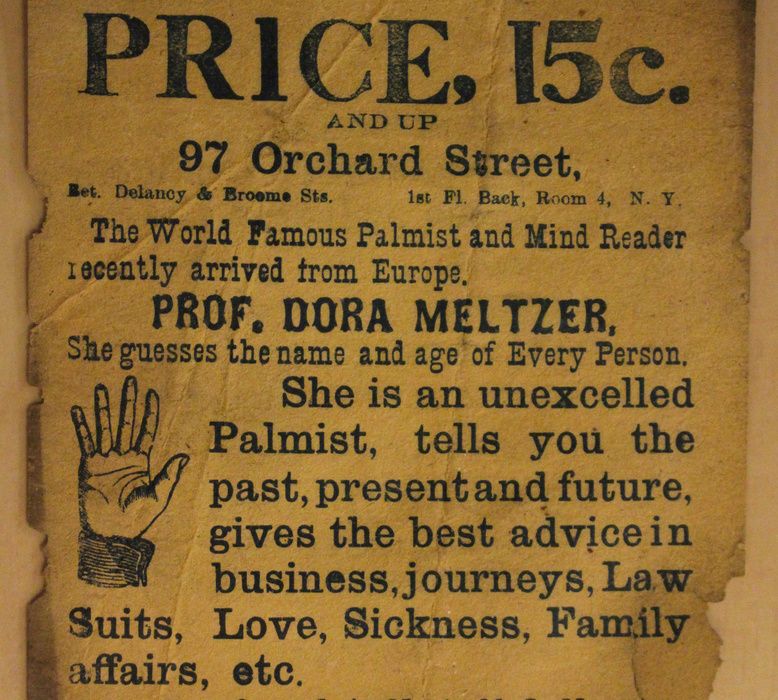
Courtesy of the Tenement Museum
The artifacts found while renovating and exploring 97 Orchard Street often offer a glimpse into its former residents’ lives. One such find was made during early renovations in the 1990s. Beneath a floorboard, the Museum found a handbill advertising palm reading and fortune-telling services. One side was written in English while the other side was written in Yiddish. For just 15 cents, you could get “the best advice in business, journeys, Law Suits, Love, Sickness, Family affairs” and more.
The services were provided by “The World Famous Palmist and Mind Reader” Dora Meltzer. Meltzer was a Russian immigrant who lived at 97 Orchard in the late 1800s. The discovery of Meltzer’s handbill kicked off a research project that sought to uncover the ways immigrant women adapted to their new lives in America. Fortune telling was a common way for immigrant housewives to bring in some money and connect with each other.
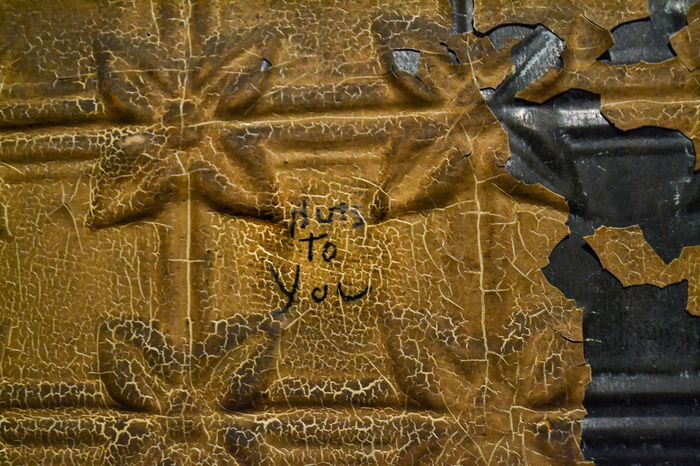
Courtesy of the Tenement Museum
97 Orchard Street has hidden “graffiti” in various places throughout the building. Some of this original artwork is displayed on the walls of the restored apartments. Writing you will find scrawled on the walls include a clothing list, a little girl’s signature, and the phrase “Nuts to You.”
The walls of the Tenement Museum literally contain layers of history. Along with the occasional handwritten remnant, you can see in unrestored sections the different wall coverings used throughout its history. Looking at the various layers of colorful paints and patterned wallpapers, it’s almost as if these walls can talk.
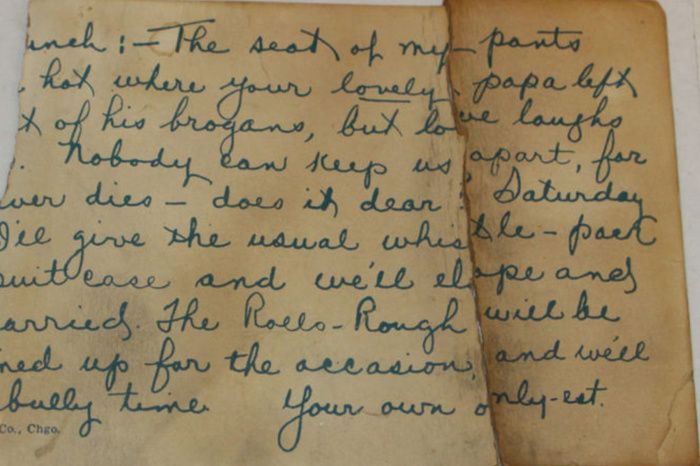
Courtesy of the Tenement Museum
A torn love letter from the early 20th century was found inside 97 Orchard Street. The letter begins, “The seat of my pants is still hot from where you lovely papa left a mark from his brogans. But love laughs last.” Brogans are a type of leather shoe popular in the early 20th-century, so it’s evident that the recipient’s “lovely papa” didn’t approve of this forbidden romance.
The endearing letter reveals one important aspect of life in the tenement, love and relationships. There were many love stories set at 97 Orchard, and you can learn more about them at the Museum’s Love at the Tenement virtual tour on February 12th, 13th, or 14th.
Bonified movie star Sam Jaffe was born at 97 Orchard Street in 1891. Jaffe has starred in such classic Hollywood films as Gunga Din, Ben Hur, and The Day the Earth Stood Still. He is also known for his small-screen roles in television shows like Ben Casey, in which he played Doctor David Zorba and was nominated for an Emmy.

Courtesy of the Tenement Museum
Each family who has lived at 97 Orchard has a fascinating and unique story to tell. The stories of these families, who come from diverse cultural backgrounds, reveal what life was like for immigrants in New York City throughout the 18th to 20th centuries. In researching the family history of past residents, there are often quirky gems that come to light. While looking into former resident Meyer Pine’s life, the Museum found that he left his wife in 1894 because “her pies gave him indigestion.” The story even made it to the pages of The New York Times. Pine was charged with abandoning his wife and ordered to pay her $3 a week.
William Lustgarten, a former resident of 97 Orchard Street, worked “undercover” for the Anti-Vice Committee of 14 to help cleaned up crime in the streets of the Lower East Side. The Committee of 14 was founded in 1905 to fight commercialized vice and the undue effects of Raines Law of 1896. Raines Law allowed hotels to sell liquor on Sundays, a right not afforded to saloons. To apply for hotel liquor licenses, many saloons added rooms. Those rooms were often used for prostitution. As part of the committee of 14, Lustgarten’s job was to identify local houses of prostitution by posing as a customer.
Turns out, Lustgarten was a bit of a criminal himself. He was later involved in serious financial fraud and faked his own death. He was eventually caught and served time in Sing Sing prison.
The land where the Museum sits on the Lower East Side is part of what was once known in the mid-17th century as Land of the Blacks, a settlement of farms and homes owned by Black residents of Mannahatta. It was the first settlement of its kind in New York, where Black residents owned land. Check out The Tenement Museum’s free upcoming Tenement Talk on February 24th to learn more about African Settlements in the 17th century.
Later, in the 19th-century, the Black population of the Lower East Side made history again. Following the ratification of the 15th amendment in 1870, which declared that “The right of citizens to vote shall not be denied or abridged on account of race, color, or previous condition of servitude,” twenty-one Black Lower East Siders were among the first to register to vote. The list included William Reese, a 108-year old self-emancipated man who lived on Delancey Street.
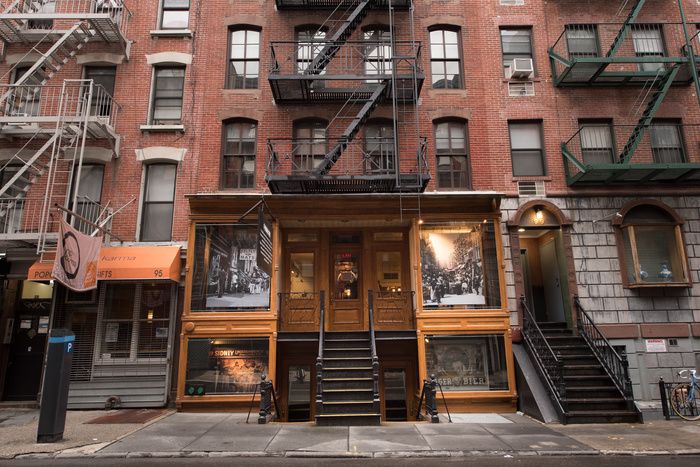
Photograph by Liz Clayman, Courtesy of the Tenement Museum
The Tenement Museum started at 97 Orchard. Inside, the Museum has restored seven restored apartments that tell the story of Lower East Side immigrants from the 1860s to the 1930s, but the story continues at 103 Orchard Street. More than 10,000 people have called 103 Orchard home since it was built in 1888. From 1888 to 1916, the families who occupied the building’s apartments were European immigrants primarily from Germany, Ireland, Austria, and Russia. As time progressed, the demographic shifted to more children and grandchildren of the original immigrants and residents from Puerto Rico and China.
The restored apartments inside 103 Orchard Street reveal the lives of families who lived there after World War II, telling the story of the Lower East Side from the 1950s through the 1980s. When you visit 103 Orchard, you will learn about the Epsteins, Jewish refugees who arrived in the 1950s, the Saez/Velez family, Puerto Ricans who witnessed the Civil Rights Movement and the Korean War, and the Wongs, a family who became part of America’s largest Chinese community.
This article was written by Nicole Saraniero with Jamie Salen, Senior Director of Marketing and Communications at The Tenement Museum
Next, check out What’s Left of Little Germany in NYC, Kleindeutschland and The Top 10 Secrets of NYC’s Lower East Side
Subscribe to our newsletter